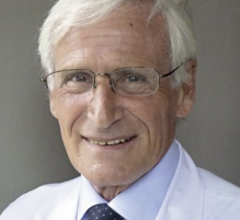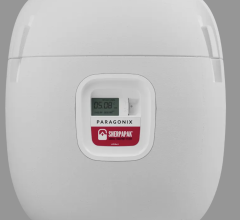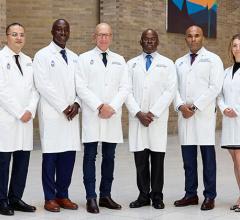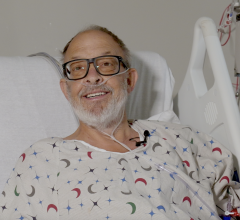
Penn Presbyterian Medical Center created this hybrid lab with help from Siemens.
Recent developments in cardiac surgery and interventional cardiology with new percutaneous alternatives for aneurysm repair, valve replacements, shunt closure devices and aortic arch reconstruction have led to the creation of integrated, hybrid cath lab/operating rooms (OR) that allow both surgical and intravascular procedures. These rooms offer both surgical equipment and high-end angiographic equipment. Creating such rooms requires special planning and design from both surgical and interventional cardiologists working closely together. Cath labs have high-quality fluoroscopy equipment, but generally are smaller rooms and lack the sterile requirements and equipment needed for surgical procedures. ORs tend to use lower quality mobile C-arms, which are not ideal for interventional procedures. The hybrids aim to provide the best of both worlds. The trend toward hybrid labs has been reinforced by digital angiography manufacturers partnering with surgical equipment companies to create easy-to-integrate hybrid room solutions with coordinated installation. Philips partners with both Skytron and Steris. Toshiba partners with MAQUET. GE Healthcare, Siemens and Toshiba also offer hybrid installations. Philips said while some hospitals want to combine interventional procedures with minimally invasive surgeries, they also want a properly equipped room in case emergency surgery is needed. Philips said hybrids also allow hospitals with lower PCI numbers to get a bigger bang for their buck by allowing the same room to serve the needs of surgeons. Penn Presbyterian Medical Center in Philadelphia, PA, created a hybrid lab with help from Siemens, which opened in November. Wilson Szeto, M.D., cardio-thoracic surgeon, and William Matthai, M.D., interventionalist, both from Penn Presbyterian said hybrid labs are ideally suited for procedures that require both percutaneous and surgical interventions, percutaneous valve replacements, deploying percutaneous septal occluders or installing aortic stent grafts. Interventionalists can also be called in after cardiac surgery to perform a completion angiography. Based on positive data from hospitals in Japan, which have been using hybrid lab/ORs for several years, Dr. Szeto wanted to bring the concept to his hospital. Penn Presbyterian is the first in its region to create such a lab. “This definitely changes the way we treat patients,” Dr. Szeto said. “The advantage with the hybrid OR is you can do bypass and percutaneous interventions in one sitting,” Dr. Matthai said. In June 2008, Rush University Medical Center in Chicago opened its Toshiba-designed hybrid cath lab/OR. Ziyad Hijazi, M.D., director of the Rush Center for Congenital and Structural Heart Disease and professor of pediatrics and internal medicine at Rush University Medical Center, said Rush wants to be a leader in the field of pediatric structural heart disease. When he accepted the job, he told the hospital that he wanted to build a state-of-the-art hybrid room. The Rush lab is primarily used for pediatric structure heart cases, including treatment for hypoplastic left heart syndrome and shunts. The hybrid is also used in some adult cases, such as pulmonary valve replacement, especially when it is known vessels are too small or tortuous to navigate percutaneously and chest access is needed. When the hybrid at Rush is not in use for OR purposes, Dr. Hijazi said it is used as a standard cath lab. Hybrids aid patient satisfaction Drs. Szeto and Matthai said they found the combined lab/OR is actually less efficient for physicians who need to coordinate their schedules. However, they said it is much more efficient for patients who do not have to plan multiple appointments for different procedures, which translates into less time off work and away from home. “Patient satisfaction is tremendous,” Dr. Szeto said. “They have one procedure and they go home, they love this.” Dr. Hijazi concurred and said, “If you take a patient to the cath lab and find you can’t do the procedure, you have to send the patient home and reschedule (for surgery). Instead of subjecting a patient to two procedures they only have to undergo one. The outcomes are much better.” He said Rush has not done a review of the costs for the hybrid, but there is a savings in time for both the patients, staff and doctors, as well as in disposables and the costs associated with preparing two rooms instead of one. Changing culture to a team approach There is a tug of war between surgeons and interventionalists who compete for patients. The hybrid lab/OR approach eliminates the turf battles between the two fields, said Drs. Szeto and Matthai. “There is a turf war, but what we want to do is bring down these barriers,” Dr. Szeto said. “The old business of turf wars is not good for patients.” They said the hybrid cath lab requires a team approach with both interventionalists and surgeons working closely together. Dr. Matthai said they can work out mutually beneficial relationships where cases that are better suited for bypass are referred to the surgeon and cases that only require angioplasty are passed to the interventionalist. He said over time it helps increase the patient volume for both doctors and it helps sort out the best intervention for the patient. “There is value to this hybrid approach, but it’s not right for every patient,” Dr. Szeto said, as some patients can be treated with medication, or may have a condition that is best treated by either surgery or PCI. “This is different than anything we have done in decades,” Dr. Szeto said. “The two fields are merging — this is the way of the future. We need to make this cultural shift.” That cultural shift will become more evident in the coming years as procedures that were once only in the realm of surgeons move to less invasive percutaneous alternatives, including the use of aortic aneurism stent grafts and percutaneous heart valve replacements. Dr. Szeto is in the middle of this shift, serving as a co-principal investigator, along with interventionalists at Penn Presbyterian, in a trial of the Edwards Life Sciences percutaneous aortic value. Numerous companies are developing first-generation percutaneously implanted valves. One issue with these procedures is a patient’s vessels may not be able to accommodate the 24 Fr. delivery catheter, which may require a surgeon to make an incision below the nipple and cut ribs to get the device to the heart. “The whole technology is going to explode over the next 10 years and that is why these hybrid ORs are so important,” Dr. Szeto said. This change in culture is also evident at interventional scientific sessions such as TCT, which is increasingly catering to cardiologists who cross the surgical, vascular and interventionalist turf boundaries. Dr. Szeto said he attended TCT 2008 to gain a better understanding of PCI procedures and technology. “Three years ago no surgeons went to this meeting and now there are numerous programs for surgeons [at TCT],” he said. Dr. Szeto said instead of the titles of “cardiac surgeon” or “cardiac interventionalist,” a new title of “cardiovascular specialist” should be adopted for both fields as they begin to work closer together. He said working together and having an open-minded understanding of both fields will help enhance what is best for the patient. “I think the patient is getting better care,” Dr. Matthai said of his relationship working with a cardiac surgeon. Planning ahead Penn Presbyterian's experience showed it takes about two or three years to plan and build a hybrid lab, and the price tag can be between $2 and $4 million. The price tag for the Rush hybrid room exceeded $3.5 million. Doctors at both sites said close coordination is needed between the surgeons and interventionalists. “The first step is getting the two of them in a room together to discuss what they would need for a combined OR/cath lab,” Dr. Szeto suggested. Seeing a hybrid lab/OR on paper is also not enough. Dr. Hijazi said visiting existing labs at other hospitals and using the lab by placing a dummy on the table and simulating a procedure is key. “The number one thing is to do a site visit,” Dr. Hijazi said. “Also, ask physicians honestly what the problems are with the room.” To plan the lab at Rush he involved not only the interventionalists and surgeons, but also the nurses, anesthesiologists and hospital infection control staff. He said the coordination and teamwork is essential to make the hybrid concept work. He said it is easy to do this in the pediatric cardiology field because he feels the surgeons and cardiologists work better together than in adult cardiology where turf battles are more common. Once the concept of the lab and the equipment needed was nailed down, Rush looked at various vendors offering hybrid installations and decided to use Toshiba. “We found the design of the lab Toshiba offered was more convenient and had better use of space,” Dr. Hijazi said. As an urban hospital near downtown Chicago with nowhere to expand, a major issue Rush encountered was the lack of space. Dr. Hijazi said it was determined 1,200 square feet was the perfect size for the hybrid to accommodate both OR and cath lab equipment and storage cabinets and still allow space for numerous doctors and nurses to move around efficiently. Dr. Hijazi said he looked at the hospital's lobby and told the hospital administration that is where the lab had to go, since no other area had a 1,200 square foot block available. At first he said hospital officials thought he was joking, but in the end part of the lobby was sacrificed. Dr. Hijazi said the Rush hybrid room was also planned with video capability for live satellite transmissions to a conference room at the hospital, or around the world. He broadcasts live cases during the annual Pediatric and Adult Interventional Cardiac Symposium (PICS-AICS).





 March 20, 2024
March 20, 2024 








